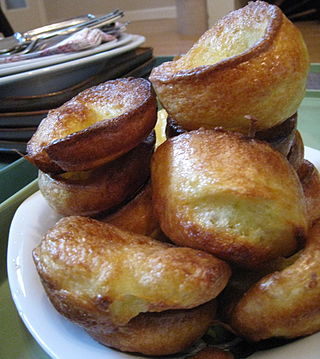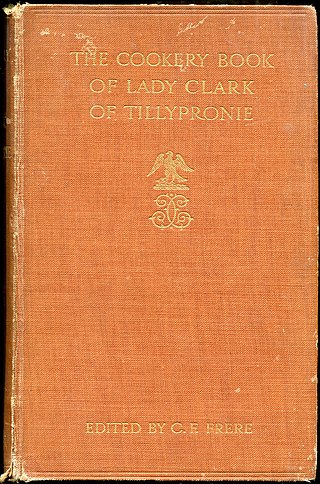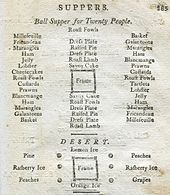
Yorkshire pudding is a baked pudding made from a batter of eggs, flour, and milk or water. A common British side dish, it is a versatile food that can be served in numerous ways depending on its ingredients, size, and the accompanying components of the meal. As a first course, it can be served with onion gravy. For a main course, it may be served with meat and gravy, and is part of the traditional Sunday roast, but can also be filled with foods such as bangers and mash to make a meal. Sausages can be added to make toad in the hole. The 18th-century cookery writer Hannah Glasse was the first to use the term "Yorkshire pudding" in print.

A pie is a baked dish which is usually made of a pastry dough casing that contains a filling of various sweet or savoury ingredients. Sweet pies may be filled with fruit, nuts, fruit preserves, brown sugar, sweetened vegetables, or with thicker fillings based on eggs and dairy. Savoury pies may be filled with meat, eggs and cheese or a mixture of meat and vegetables.

The Forme of Cury is an extensive 14th-century collection of medieval English recipes. Although the original manuscript is lost, the text appears in nine manuscripts, the most famous in the form of a scroll with a headnote citing it as the work of "the chief Master Cooks of King Richard II". The name The Forme of Cury is generally used for the family of recipes rather than any single manuscript text. It is among the oldest extant English cookery books, and the earliest known to mention olive oil, gourds, and spices such as mace and cloves.

The Art of Cookery Made Plain and Easy is a cookbook by Hannah Glasse (1708–1770) first published in 1747. It was a bestseller for a century after its first publication, dominating the English-speaking market and making Glasse one of the most famous cookbook authors of her time. The book ran through at least 40 editions, many of which were copied without explicit author consent. It was published in Dublin from 1748, and in America from 1805.

Fricassee or fricassée is a stew made with pieces of meat that have been browned in butter then served in a sauce flavored with the cooking stock. Fricassee is usually made with chicken, veal or rabbit, with variations limited only by what ingredients the cook has at hand.

Chicken and dumplings is a soup that consists of a chicken cooked in water, with the resulting chicken broth being used to cook the dumplings by boiling. A dumpling—in this context—is a biscuit dough, which is a mixture of flour, shortening, and liquid. The dumplings are either rolled out flat, dropped, or formed into a ball.

Game pie is a form of meat pie featuring game. The dish dates from Roman times when the main ingredients were wild birds and animals such as partridge, pheasant, deer, and hare. The pies reached their most elaborate form in Victorian England, with complex recipes and specialized moulds and serving dishes. Modern versions are simpler but savoury combinations of rabbit, venison, pigeon, pheasant, and other commercially available game.

Nun's puffs are a dessert pastry originally from France, where they were known as pets de nonne. They are now also produced in French Canada, the United States, England, and Spain.

A New System of Domestic Cookery, first published in 1806 by Maria Rundell, was the most popular English cookbook of the first half of the nineteenth century; it is often referred to simply as "Mrs Rundell", but its full title is A New System of Domestic Cookery: Formed Upon Principles of Economy; and Adapted to the Use of Private Families.

The Accomplisht Cook is an English cookery book published by the professional cook Robert May in 1660, and the first to group recipes logically into 24 sections. It was much the largest cookery book in England up to that time, providing numerous recipes for boiling, roasting, and frying meat, and others for salads, puddings, sauces, and baking. Eight of the sections are devoted to fish, with separate sections for carp, pike, salmon, sturgeon, and shellfish. Another section covers only eggs; and the next only artichokes.

The Cookery Book of Lady Clark of Tillypronie is a book of recipes collected over a lifetime by Charlotte, Lady Clark of Tillypronie, and published posthumously in 1909. The earliest recipe was collected in 1841; the last in 1897. The book was edited by the artist Catherine Frances Frere, who had seen two other cookery books through to publication, at the request of Clark's husband.

The Experienced English Housekeeper is a cookery book by the English businesswoman Elizabeth Raffald (1733–1781). It was first published in 1769, and went through 13 authorised editions and at least 23 pirated ones.

Modern Cookery for Private Families is an English cookery book by Eliza Acton. It was first published by Longmans in 1845, and was a best-seller, running through 13 editions by 1853, though its sales were later overtaken by Mrs Beeton. On the strength of the book, Delia Smith called Acton "the best writer of recipes in the English language", while Elizabeth David wondered why "this peerless writer" had been eclipsed by such inferior and inexperienced imitators.

The Modern Cook was the first cookery book by the Anglo-Italian cook Charles Elmé Francatelli (1805–1876). It was first published in 1846. It was popular for half a century in the Victorian era, running through 29 London editions by 1896. It was also published in America.
Battalia pie is an English large game pie, or occasionally a fish pie, filled with many small "blessed" pieces, beatilles, of offal, in a gravy made from meat stock flavoured with spices and lemon. The dish was described in cookery books of the 17th and 18th centuries.

The Cooks and Confectioners Dictionary: or, the Accomplish'd Housewives Companion was a cookery book written by John Nott and first published in London in 1723.

The Queen-like Closet, Or, Rich Cabinet was a cookery book published in 1670 by the English writer on household management, Hannah Woolley. It ran through five English editions by 1684. At least two German editions were also printed.

The English Art of Cookery is a cookery book of English cuisine by the tavern cook Richard Briggs, first published in 1788.

David Hughson, which may have been a pen name of Edward Pugh, was a writer on the topography and history of London. He produced a description of the city based on "an actual perambulation" (walk) that was published in six volumes between 1805 and 1809 and contains 150 copper plate engravings principally based on illustrations by Robert Blemmell Schnebbelie and Edward Gyfford. He also produced works on topical matters such as the East India Company, religious subjects, and works of household management targeted at people of the "middling and genteel ranks of life".

The Lady's Complete Guide, or Cookery in All its Branches by Mary Cole is a pioneering cookery book, the first in English that systematically ascribed recipes to their authors, where known. It was first published in 1788 and was followed by revised editions in 1789 and 1791.






















